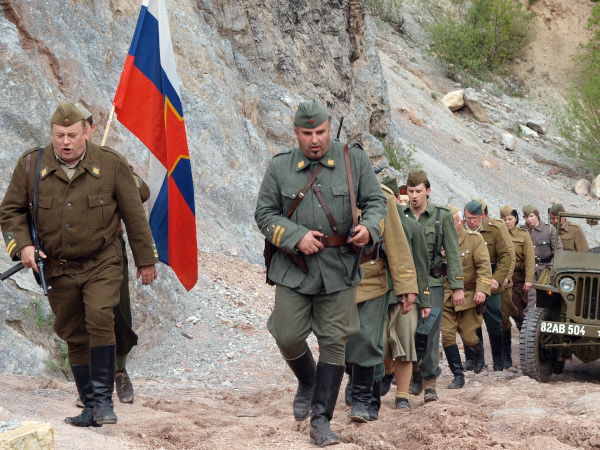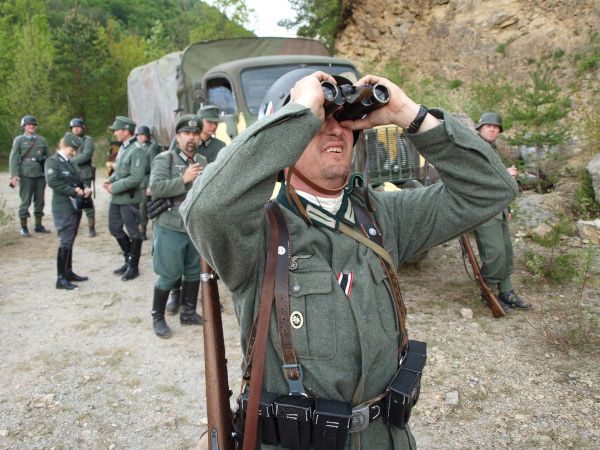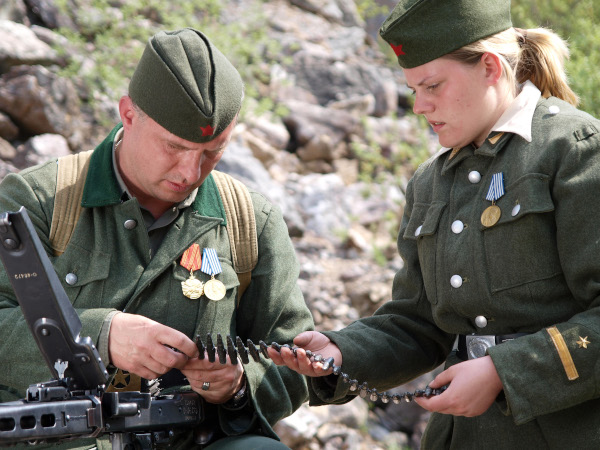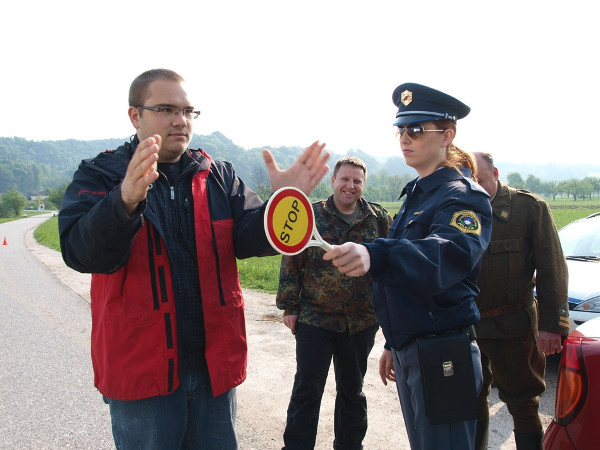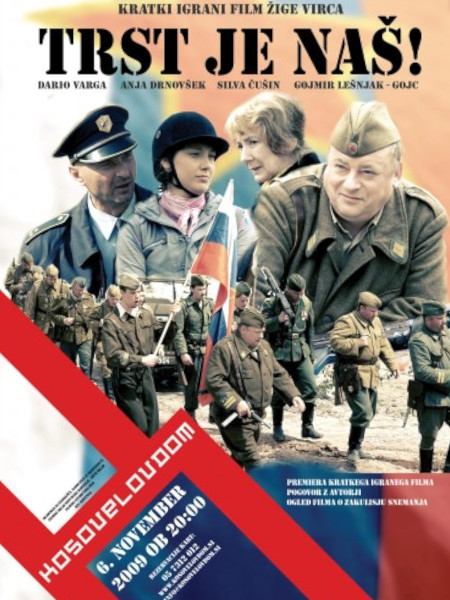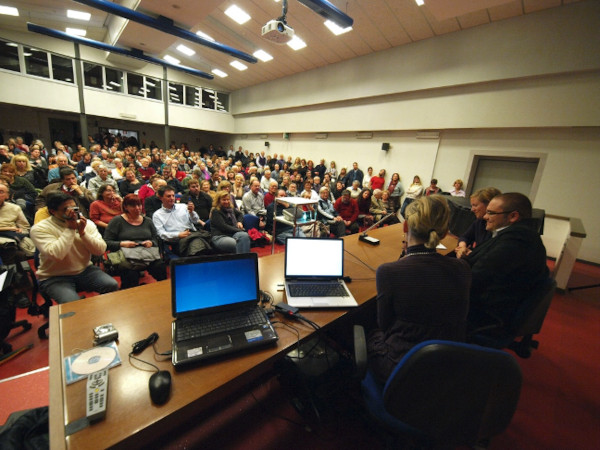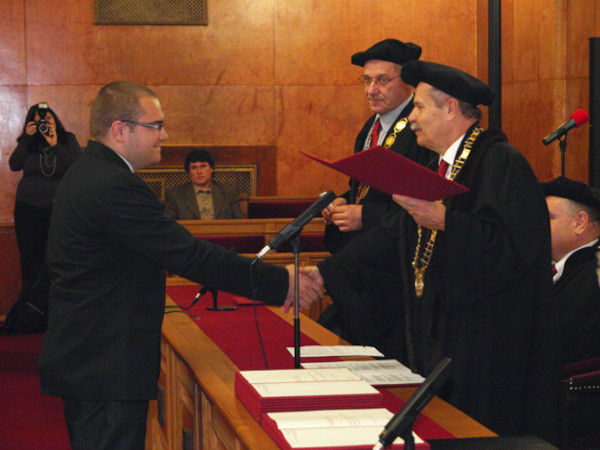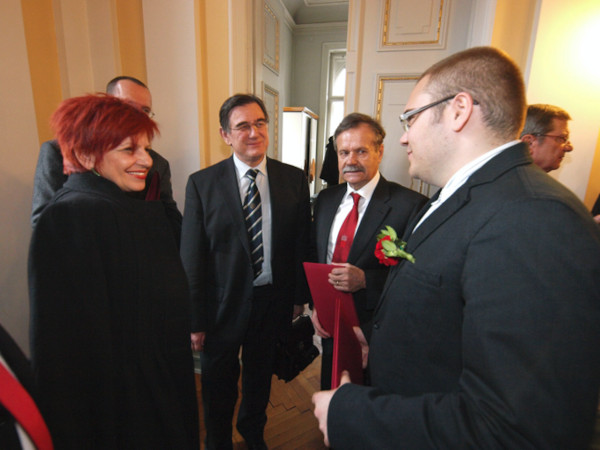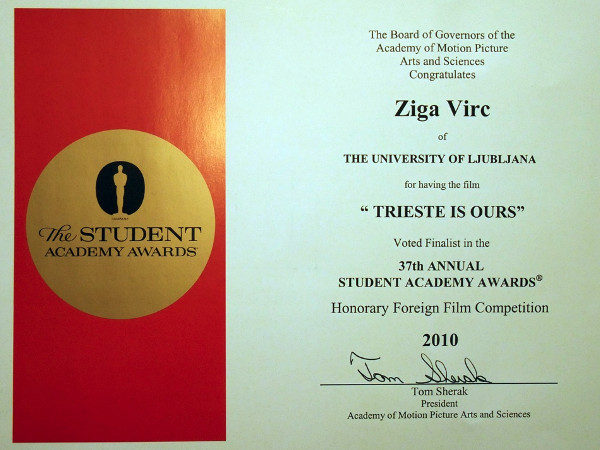Trieste is Ours! (2009)
Trst je naš! [SLV]
In the year 2009 a small group of Slovenian enthusiasts organised by the middle-aged man France decide to “liberate” the Italian city of Trieste. They dress in the Yugoslav partisan uniforms from WWII, get the guns and start preparing for the big imaginary battle.
- Film kind: short fiction, comedy
- Duration: 27’ 37’’
- Year: 2009
- Format: S-16mm, 1,77:1, colour, stereo
- Country: SVN
- Language: Slovenian
- Director: Žiga Virc
- Screenplay: Žiga Virc
- Director of photography: Jure Černec
- Editing: Janez Bricelj
- Production: Academy of Theatre, Radio, Film and Television (University of Ljubljana) - UL AGRFT (final student production project, academic year 2008/2009) and RTV Slovenia
- Release date: September 22, 2009
- Cast: Gojmir Lešnjak (Franc), Silva Čušin (Marija), Anja Drnovšek (Actor, Mateja), Dario Varga (Brane), Nina Rakovec (Policewoman 1), Tina Potočnik Vrhovnik (Policewoman 2), Miha Bezeljak (Marko), Jernej Čampelj (soldier Žiga), Tina Gunzek (nurse Franja)
- Supervisors: Stanko Kostanjevac (editing), Miran Zupanič (directing), Miroslav Mandić and Barbara Orel (screenplay)
- Full cast and credits available in the online catalogue of Slovenian film and theatre.
- Film festivals – competition only: 6th Asterfest (international short film festival, Strumica, North Macedonia, 2010), 13th Festival of Slovenian Film [Festival slovenskega filma] - FSF (Portorož, Slovenia, 2010), 18th Skomrahi (international festival of art academies, Skopje, North Macedonia, 2010), 12th International Student Film Festival [Festival studentskog filma - FSF] (Belgrade, Serbia, 2011).
- Awards: The “Vesna“ Award for the best male role in the 13th Festival of Slovenian Film (2010); the “Prešern“ Award [SLV] awarded by the University of Ljubljana (2009); three Zlatolaska Award – the UL AGRFT’s annual award [SLV], given by students to fellow students – for best directing, best screenplay and best film (all three to Žiga Virc, 2009).
- Nominations: Nomination for the Student Academy Awards in the category best foreign student film (Honorary Foreign Film Awards), selected for the top five nominees (2010).
- Other screenings: The film has had more than 30 special screenings in various film festivals, academic seminars and other film events (a partial list is available).
- TV broadcast: Radio Television Slovenia, Channel 1, December 2, 2009 at 9 pm.
Videogallery
Photogallery
Film stills
Other images
Long synopsis
In the year 2009 a small group of Slovenian enthusiasts organised by the middle-aged man France decides to “liberate” the Italian city of Trieste. They dress in the Yugoslav partisan uniforms from WWII, get the guns and start playing “partisans and Germans”. However, France’s wife Marija and young-adult daughter Mateja do not support France in this activity of his. Neither do the police who forbid him to continue. However, France is unstoppable, motivated by the desire to pass to his daughter and her generation the socialist legacy and values of the partisan movement. Will he succeed in convincing her to align with him? Will his fictional army manage to liberate Trieste again, just like the Yugoslav partisans did in 1945?
Festival circulation
As a student film, Trieste is Ours! has had an excellent regional circulation, being in competition of four film festivals (Festival of Slovenian Film, Asterfest and Skomrahi in 2010, and the Student Film Festival in Belgrade in 2011). It was also a part of non-competitive and special programmes of more than 30 other festivals and film events. Apart from multiple displays across Slovenia, it has also been shown in the wider post-Yugoslav space (Serbia and North Macedonia), in Italy (Trieste), as well as in Germany, at the Humboldt University in Berlin. Photographs from some of those screenings can be found online, for instance from the one in the multimedia centre KIBLA in Maribor on November 28, 2009.
Media and public interest
The film sparked considerable media interest as soon as its premiere was announced, due to the public condemnation by various Italian politicians, starting with the back then Minister of Foreign Affairs Franco Frattini.
The premiere was scheduled for Friday, November 6, 2009, in the small border-town of Sežana, Karst region (Slovenian: Kras, Italian: Carso), Slovenia. According to Virc (Virc’s memories of these first screenings and the controversy around them are detailed in the text “Bo Trst naš, ali njihov?“ [Will Trieste be ours or theirs?] - Oderuh, gledališki list Akademije za gledališče, radio, film in televizijo, No. IV/1, 2009–2010, pp. 116-118), the location was chosen somewhat randomly, because the film’s main actor Gojmir Lešnjak, served as the head of Kosovelov dom [SLV], a cultural centre located in Sežana.Worried that Kosovelov dom’s 50 seat room would be too big for the event, they printed some posters to announce the screening and assure that the audience included people other than their family, friends and colleagues. The poster featured the inscription Trieste is ours! and images of men and women dressed in partisan uniforms, scenes from the film. Just after the posters appeared in the streets of Sežana, negative reactions from Italy commenced, and several interest organisations and/or "esuli" associations vocally protested. They were joined by Frattini, who on November 5, 2009, one day before the premiere, reacted in form of an official statement published on the Ministry’s website. Although Frattini did not see the film that had not yet been publicly shown, he said [ITA] that Trieste is ours! “poured salt” on Italian wounds and that he was “shocked” that such a film was produced by the Slovenian film academy. All this provoked a chain of (negative) reactions, and a huge public interest for the film. In his graduation paper, Virc wrote: “Two days before the planned screening, the cultural centre Kosovelov dom received threats from some extremist groups from Italy. We did not know how serious they were. On the other hand, the tickets were snapped up five days before the screening. The police in Sežana therefore tightened control of the town’s entrance streets as well as the ones around the Kosovelov dom; there was also a greater number of plainclothes police officers in the movie theatre.” (Žiga Virc, “Trst je naša demokracija” [Trieste is our democracy], unpublished final paper, UL, AGRFT, 2011, p. 18). Virc also remembers (Virc’s memories of these first screenings and the controversy around them are detailed in the text “Bo Trst naš, ali njihov?“ [Will Trieste be ours or theirs?] - Oderuh, gledališki list Akademije za gledališče, radio, film in televizijo, No. IV/1, 2009–2010, pp. 116-118) that he decided to turn off the comment option below the film’s trailer on his Youtube channel, due to an overload of insults. He assumes that the word about the screening reached Italy so quickly because Sežana is in Trieste’s immediate vicinity, 17km away, and locals circulate around. Hence, what was originally planned to be a small event, became a big one. The event was moved to the cultural centre’s biggest room. Journalists from Italy, Slovenia and Croatia came. The originally planned screening was followed by four more, on Saturday and Sunday (two screenings per day, at 5PM and 8 PM, November 7-8). These five screenings gathered in total 1700 viewers (Virc, op. cit, 2011, p. 20).
Frattini’s condemning statement was covered by various Italian and Slovenian media, including the Italian newspapers “Il Piccolo" [ITA] and “La Repubblica" [ITA], Croatian “Jutarnji List" [HRV], Slovenian “Dnevnik" [SLO] and “Mladina" [SLO], Radio Television of Slovenia [SLO], and online cinema outlets such as Cinecittanews.it [ITA]. Negative reviews of the film can be found on the websites of the association of Italian diaspora from Pula and Istria L’Arena di Pola [ITA] [Associazione Italiani di Pola e Istria – Libero comune di Pola in esilio], while the National Association Venezia Giulia Dalmazia, ANVGD [Associazione nazionale Venezia Giulia Dalmazia] shared “La Repubblica”'s article [ITA] listing negative reactions to the film. The film has also been discussed on the portals Bora.la [ITA], Osservatorio Balcani e Caucaso Transeuropa [ITA], Svet 24 [SLO], and others. The press clipping collected by Virc has more than 300 pages (Virc, op. cit, 2011, pp. 18-19).
Virc has claimed that he is grateful to Frattini [ITA] for helping film gain big visibility with his statement, which he has included in the film’s official trailer. Indeed, thanks to political controversy that it provoked, the film has had a much wider media coverage than what a student film, made by a 22-year-old filmmaker, would typically have. Its visibility was also aided by the local nomination for the student Oscars (2010), multiple awards won, and good regional circulation.
An academic analysis of the film is available in the open access article “The Cinematic Battle for the Adriatic: Film Festivals and the Trieste Crisis”, “Cinergie – Il cinema e le altre arti”, N.22 University of Bologna, 2022, pp. 55-68.
About the filmmaker
Žiga Virc (1987) graduated from the Academy of Theatre, Radio, Film and Television (AGRFT, University of Ljubljana) in Film and Television Directing in 2011. Following his graduation film Trieste is Ours!, he has directed numerous commercials, documentaries and fiction films, many of which within his production house Studio Virc.
NB: The film’s title makes a reference to the slogan “Trieste is Ours” [Trst je naš], which was widely used across Yugoslavia during the Trieste Crisis within the protests related to the status of the town and the disputed area. The slogan suggests that the town is part of the Slavic cultural space and that as such it should become a part of Yugoslavia.


